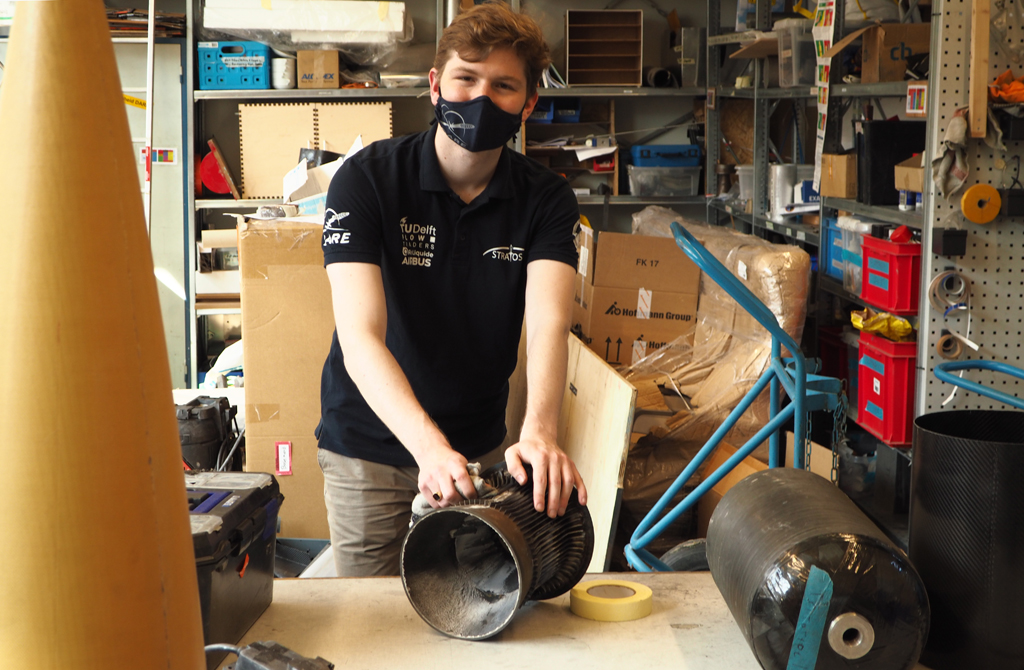Just like two years ago, the DARE TU Delft student rocket team has announced a record attempt with their Stratos IV rocket. What is different this time round?
Team manager Willem van Lynden in the DARE workshop in the Dream hall. (Photo: Jos Wassink)
“We will make space flight cheaper and greener,” is how master’s student Willem van Lynden puts the mission of student rocketry association DARE. He studies aerospace engineering at the Aerospace Engineering Faculty, but for the last two years he has been especially busy as team manager with the overhaul of Stratos IV, DARE’s 8.3-metre flagship. “We are combining aerospace with a down-to-earth approach,” Van Lynden explains.
‘DARE rocket team shoots for space’, Delta wrote in February 2019 about the presentation of the Stratos IV rocket. It was to reach the Kármán line at 100 kilometres altitude, which is considered the edge of space. Because of the wide range of the flight, the team had planned to launch from South Africa in the direction of the South Pole.
The new team has a pragmatic approach
After that, a long silence followed. Until a recent announcement from Delft Aerospace Rocket Engineering (DARE) that they’re preparing to beat the 2007 world record by the Embry-Riddle Aeronautical University of 20,000 feet or 61 kilometres.
End of the engine
The 8.3 metre long Stratos IV has a hybrid engine, composed of solid fuel blocks underneath a cylinder of oxidiser (nitrous oxide, NO, also known as laughing gas). It’s a safe system that stops burning as soon as the NO flow is interrupted. That means the end of the engine.
Previously, burn times were often shorter than planned because of cracks in the solid fuel block (a thick 2-metre-long cylinder that burns from the inside out). Flames would tear through a crack and burn a hole in the casing.
Team manager Willem van Lynden says that two years ago the team experienced delays in the engine development and that the planned launch from South Africa had proved too expensive. With the arrival of the new team, Project Stratos landed on its feet.
The new team’s pragmatic approach included a thorough overhaul of the engine, replacing the steel engine casing with an 8-10 kilogram lighter carbon fibre one (“every kilogram equals a kilometre”), and choosing the INTA base in Spain as their launch pad.
Limited reach
Van Lynden tells that all the fuel blocks are now being inspected with a CT scanner to ensure their homogeneity. The connections between cylinder blocks, which are basically melted on top of each other, are also being inspected.
Every piece and part will be inspected
According to their calculations, 39 seconds of burn time would boost the Stratos IV to the Kármán line. But there is little chance they will keep the engine on for that long.
The maximum reach from the Spanish INTA base is limited, which means that the rocket is not allowed to land outside that area. Van Lynden therefore expects that the burn will need to be interrupted somewhere halfway, but late enough to reach the 61 kilometres apogee and set a new official world record.


Team photo of the DARE Stratos team. (Photo: DARE)
A crowdfunding has been set up to support the students during their four week autumn stay in Spain. They’ll need that time “to be a 100% sure of the rocket and to be 100% sure that it will remain inside INTA’s safe zone.” Every piece and part will be inspected, the whole rocket will be assembled, and ‘dress rehearsals’ will be held until the whole launch is a drilled routine. The launch is scheduled between 11 and 25 October.
See how DARE deals with Christmas trees.
- Read also the interview with Lucia Cramer, DARE’s chief of propulsion.
Do you have a question or comment about this article?
j.w.wassink@tudelft.nl


Comments are closed.